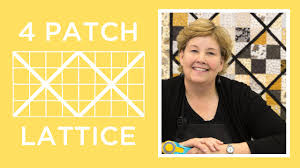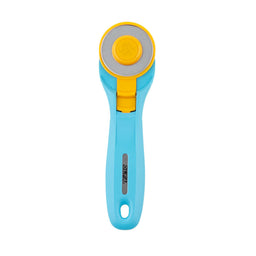Four Patch Lattice Quilt Tutorial
Jenny Doan
Four Patch Lattice Quilt Tutorial
- 4 packs x 5" Precut Fabric Squares (Charm Packs)
- 1 yard x Background Fabric
- 1.5 yards x Outer Border Fabric
- 4.5 yards x Backing Fabric

Finish your masterpiece and let us give it the finishing touch it deserves.
Subscribe to MSQC on YouTube
Hundreds of FREE tutorials and a new one from Jenny launches every Friday.
video transcript
Hi everybody. It’s Jenny from the MSQC. And I’m delighted to be here today and can’t wait to show you how to do this quilt. So let’s take a look at this quilt behind me. Isn’t this fun? I love the lattice work. I love the simplicity of it. But it looks like you worked really hard. So to make this quilt what you’re going to need are four packs of five inch squares. There’s 42 squares in each pack and you’re going to need four of those. Or you could use a layer cake which is ten inch squares that you would cut in fourths. But anytime I can get it pre-cut, I love it. And we’ve used Bee Creative by Deb Strain for Moda. It’s a great line. Bees must be really popular this year because there are several bee lines. And this one, I just love. I love the colors. I love the way it goes together. I love Deb Strain. So we love everything about that. Also you’re going to need a yard of background fabric for your, for your lattices right here. These, that also includes that first little inch and a half border. For your outer border, it’s a six inch border and you’re going to need a yard and a half of fabric. And let me show you how to make this, because this goes together so quick and easy and it’s just fun.
So what we’re going to do is we’re going to open up our pack. And we are going to choose four squares. And we’re going to make a four patch. So we’re just going to put these together. We like to mix them up a little bit and just like that. You don’t want all the same color. You can have lights and darks. You can have different colors. We just want to put a four patch together that is mixed up. So to make a four patch you’re going to use four squares that are the same size. And we are going to sew two together, these two together up here. And these two together down here. So let’s go ahead and do that.
So over here at the sewing machine I’m going to line these up together. And I’m just going to set my, my presser foot foot down on the edge and I’m going to sew a quarter of an inch down the side. So here we go. And then I’m going to chain piece the next set right in behind it. So line those up and slide those under the foot as well. Alrighty, now what we’re going to do is we’re going to clip those apart and we are going to press these open so we head over to the ironing board over here and I am going to press these. You want to press them opposite directions so we’re going to make sure these run the opposite way. You can do that by putting your same lights on the same side because you know you’re going to flip those around. So you can see here, now I have two seams going the different directions. And we are going to lay those right on top of each other and sew, sew a quarter of an inch right down the side of that. Nest up those seams. You can feel with your fingers if they’re lined up or not and you’ll want to make sure those are lined up nice and tight. Alright, now we’re going to clip that off. And now we get to press it open. And we’ll see how good we did on that center seam. Oh, oh perfect. Love it when they nest right together. And you’ll really get to where you can feel that with your fingers. So now you have this little four patch like this. And what we’re going to do with our four patches, is we are then going to take them and we are going to cut them diagonally one time. Just one direction. And what’s fun about cutting this diagonally is you’re going to match up your corners here. And you’re going to match up where they come together in the middle. And you’re going to cut right across those.
Now the benefit of, of this right here is if this isn’t perfect, this is now going to be hidden because what we’re going to do is we’re going to add a lattice in there. So to add your lattices, what you’re going to do is you’re going to take and cut inch and a half strips. And you’re going to cut three, I think you cut about 14 of those. And you’re going to cut three 14 pieces out of each strip. And so let’s go ahead and do that. I’ve already cut my strips as you can see. And so I’m just going to cut my selvedge ends off right here. I’m going to use this little ruler because it’s a lot handier to use a little ruler with a little fabric. So now we’re, we’re going to line this up right here on this and I’m going to count over 14, one, two, three, four, five, six, seven, eight, nine, ten, eleven, twelve, thirteen, fourteen. And you’re going to get three cuts out of each strip because then you’re going to open this up and you’re going to cut it as well. And 14 is our magic number on these because that’s, that’s just long enough to go diagonally across that block.
So once you get your strips cut, you’re going to want to fold those together like this and press a center line. So I’m just finger pressing right here and making a crease because we need the center of this strip to line up with this spot right here with these blocks come together. Because that’s the center of our block. So we’re going to lay that right on there like that and we are going to go over to the sewing machine and sew a quarter of an inch right down the side of this. And you want to make sure, take a little look and make sure that your strip does extend beyond your block. It should. It shouldn’t have any trouble at all. Make sure they stay lined up all the way down. So once you get that side sewn on, you’re going to come over and you’re going to add your other side. Now if you want to you can mix these up. You know so if you have a whole bunch of these cut you could add a different piece to it. I’m going to go ahead and put the same one on here because that’s what I’ve got. Remember I’m going to, and I’m going to finger press this down right here because now we want to match this side up again with that same crease that’s right there. We don’t want to lose that crease right there. And so we’re going to line that up on there just like that. You can put a pin in there if you want to. And then we are going to sew this a quarter of an inch as well. And there we go.
Alright so now we are going to iron it back with the, not just finger press but iron. And I’m going to kind of set this and roll it back. And then I’m going to flip this over and make sure those seams are going the way I want them to. And I want them to go out from the center. I think that’s a personal preference. It doesn’t really matter. But I’m going to iron them so they go out. I actually really like ironing from the top because what you’re looking for is a flat quilt block. And this one is nice and flat. Alright so now we have to clean up these corners right here. There’s two ways to do that. One you can fold it in half like this and then you can just slice off that end like that. You know it makes it real easy. So we’ll do one that way. Just line your ruler up right along the edge of your block right here. And then come down and just cut that, that little point off right there. And that’s going to make our corner point. And the other way you can do it, you know everybody is comfortable with different ways. So I’m just going to show you two. You can line up your along the edge of your fabric like this and cut that side. And then come over here and again you use your fabric as your guide and you cut the point. So then you have a point on both sides. So your whole block is done now.
So let’s go ahead and see how these set together because it’s fun to lay these out. Now you can see on this one, like I have different halves on each one which, which I think, it doesn’t really matter. It’s kind of fun. It gives it a more scrappy look if you do that. But you can lay these out however you want. We’ve got ours latticing throughout the whole quilt. So as long as you put them together so that these little strips match up here. Let me get this out of the way so you can see. It will make all the, it will make all the squares. Now see I just had this right here, these are the same. I don’t want that to happen so we’re going to turn it. And that’s kind of the same too so I’m just going to bring this over here and move it to the next one. And I’ll put this one over here. So see how they all come together. I mean it’s just a great way to, a great quick fun way to make a quilt with a little pizzazz to it.
Alright so let’s look at the quilt behind us. We have back here, these are our four patches right here with our one line through them. And we have one, two, three, four, five, six of those blocks, six of these across. And then seven down. So we end up with 42 blocks. That’s going to give you a quilt that is, let’s see what size it is, 67 by 76 so it’s a pretty good sized quilt. And it comes out really nice. Once you get your blocks sewn together you’re going to add your first little inch and a half border and then you’re going to add your six inch outer border. And you’re going to be good to go. So we hope you enjoyed this tutorial on the lattice four patch from the MSQC.
& Progress on Social






